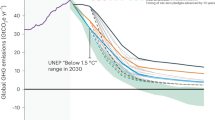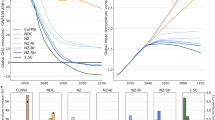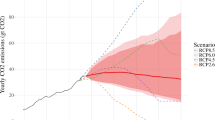Abstract
National net zero emission targets could, if fully implemented, reduce best estimates of projected global average temperature increase to 2.0–2.4 °C by 2100, bringing the Paris Agreement temperature goal within reach. A total of 131 countries are discussing, have announced or have adopted net zero targets, covering 72% of global emissions. These targets could substantially lower projected warming as compared to currently implemented policies (2.9–3.2 °C) or pledges submitted to the Paris Agreement (2.4–2.9 °C).
This is a preview of subscription content, access via your institution
Access options
Access Nature and 54 other Nature Portfolio journals
Get Nature+, our best-value online-access subscription
$29.99 / 30 days
cancel any time
Subscribe to this journal
Receive 12 print issues and online access
$209.00 per year
only $17.42 per issue
Buy this article
- Purchase on Springer Link
- Instant access to full article PDF
Prices may be subject to local taxes which are calculated during checkout

Similar content being viewed by others
Data availability
Global emissions data used by the CAT approach as well as associated figure code are available at https://github.com/climate-analytics/wave_of_net_zero_targets. All other data not already available in publicly available locations are made available in the Supplementary Tables.
References
Rogelj, J. et al. Paris Agreement climate proposals need a boost to keep warming well below 2 °C. Nature 534, 631–639 (2016).
Emissions Gap Report 2018 (UNEP, January 2019); https://doi.org/10.18356/08bd6547-en
Emissions Gap Report 2020 (UNEP, UNEP DTU Partnership, 2020); https://www.unep.org/emissions-gap-report-2020
Höhne, N. et al. Emissions: world has four times the work or one-third of the time. Nature 579, 25–28 (2020).
Geiges, A. et al. Incremental improvements of 2030 targets insufficient to achieve the Paris Agreement goals. Earth Syst. Dyn. 11, 697–708 (2020); https://doi.org/10.5194/esd-11-697-2020
Decision 1/CP.21: Adoption of the Paris Agreement (UNFCCC, 2015); https://unfccc.int/files/home/application/pdf/decision1cp21.pdf
Haites, E., Yamin, F. & Höhne, N. Possible elements of a 2015 agreement to address climate change. Carbon Clim. Law Rev. 8, 3–12 (2014).
Rogelj, J. et al. Zero emission targets as long-term global goals for climate protection. Environ. Res. Lett. 10, 105007 (2015).
IPCC. Special Report on Global Warming of 1.5 °C (eds Masson-Delmotte, V. et al.) (WMO, 2018).
Proposal for a Regulation of the European Parliament and of the Council: Establishing the Framework for Achieving Climate Neutrality and Amending Regulation (EU) 2018/1999 (European Climate Law) (European Commission, 2020); https://ec.europa.eu/info/sites/default/files/commission-proposal-regulation-european-climate-law-march-2020_en.pdf
Statement by H.E. Xi Jinping President of the People’s Republic of China at the General Debate of the 75th Session of The United Nations General Assembly (FMPRC, 2020); https://www.fmprc.gov.cn/mfa_eng/zxxx_662805/t1817098.shtml
South Africa’s Low-Emission Development Strategy 2050 (Republic of South Africa, 2020).
Canadian Net-Zero Emissions Accountability Act Bill C-12 (Government of Canada, 2021).
Lies, E. Japan Aims for Zero Emissions, Carbon Neutral Society by 2050—PM (Reuters, 2020); https://www.reuters.com/article/japan-politics-suga-idUSKBN27B0FB
Cha, S. South Korea’s Moon Targets Carbon Neutrality by 2050 (Reuters, 2020); https://www.reuters.com/article/ussouthkora-environment-greenewdeal-idUSKBN27D1DU
Executive Order 14008 of January 27, 2021: Tackling the Climate Crisis at Home and Abroad Federal Register 86 (The White House, 2021).
Net Zero Tracker (ECIU, 2021); https://eciu.net/netzerotracker
Olivier, J. G. J. & Peters, J. A. H. W. Trends in Global CO2 and Total Greenhouse Gas Emissions: 2019 Report (PBL Netherlands Environmental Assessment Agency, 2020).
CAT Warming Projections Global Update (Climate Action Tracker, 2021).
Paris Agreement Turning Point: Wave of Net Zero Targets Reduces Warming Estimate to 2.1 °C in 2100—All Eyes on 2030 Targets (Climate Action Tracker, 2020).
IPCC. Climate Change 2014: Mitigation of Climate Change (eds Edenhofer, O. et al.) (Cambridge Univ. Press, 2014); https://doi.org/10.1017/CBO9781107415416
Gütschow, J., Jeffery, M., Schaeffer, M. & Hare, B. Extending near-term emissions scenarios to assess warming implications of Paris Agreement NDCs. Earth’s Future 6, 1242–1259 (2018).
Meinshausen, M., Raper, S. C. B. & Wigley, T. M. L. Emulating coupled atmosphere–ocean and carbon cycle models with a simpler model, MAGICC6—Part 1: Model description and calibration. Atmos. Chem. Phys. 11, 1417–1456 (2011).
den Elzen, M. et al. Are the G20 economies making enough progress to meet their NDC targets? Energy Policy 126, 238–250 (2019).
Jeffery, M. L., Gütschow, J., Rocha, M. R. & Gieseke, R. Measuring success: improving assessments of aggregate greenhouse gas emissions reduction goals. Earth’s Future 6, 1260–1274 (2018).
IPCC. Climate Change 2013: The Physical Science Basis (eds Stocker, T. F. et al.) (Cambridge Univ. Press, 2013).
Gidden, M. et al. A methodology and implementation of automated emissions harmonization for use in integrated assessment models. Environ. Model. Softw. 105, 187–200 (2018).
Meinshausen, M. et al. Greenhouse-gas emission targets for limiting global warming to 2 °C. Nature 458, 1158–1162 (2009).
Acknowledgements
We acknowledge the work of the IAM modellers for developing the IPCC AR5 and SR15 scenario databases and the MAGICC climate modelling team. N.H., M.J.G., F.H, C.F., A.G., M.L.J., S.G-Z, S.M. and W.H acknowledge funding support from the German Federal Ministry for the Environment, Nature Conservation and Nuclear Safety (grant no. 16_I_291_Global_A_CAT). J.R. acknowledges support by funding through the European Union’s Horizon 2020 Research and Innovation Programme under grant no. 820829 (CONSTRAIN).
Author information
Authors and Affiliations
Contributions
All authors contributed to parts of the research and analysis. N.H. and M.G. conceived of and coordinated the writing of the paper. N.H., M.G., M.d.E. and J.R. developed the initial draft of the paper. J.R. and A.G. produced the figures and data tables. All authors contributed to the interpretation and analysis of the results as well as writing the paper.
Corresponding authors
Ethics declarations
Competing interests
The authors declare no competing interests.
Additional information
Peer review information Nature Climate Change thanks Stefano Caserini, Rob Dellink, Kejun Jiang and the other, anonymous, reviewer(s) for their contribution to the peer review of this work.
Publisher’s note Springer Nature remains neutral with regard to jurisdictional claims in published maps and institutional affiliations.
Supplementary information
Supplementary Information
Supplementary Figs. 1–3, Discussion, Tables 1–5 and References.
Rights and permissions
About this article
Cite this article
Höhne, N., Gidden, M.J., den Elzen, M. et al. Wave of net zero emission targets opens window to meeting the Paris Agreement. Nat. Clim. Chang. 11, 820–822 (2021). https://doi.org/10.1038/s41558-021-01142-2
Received:
Accepted:
Published:
Issue Date:
DOI: https://doi.org/10.1038/s41558-021-01142-2
This article is cited by
-
Paris targets within reach by aligning, broadening and strengthening net-zero pledges
Communications Earth & Environment (2024)
-
Research on China’s regional carbon quota allocation based on the entropy weight-TOPSIS method and CRITIC-VIKOR model
Environment, Development and Sustainability (2024)
-
Impact of population aging on future temperature-related mortality at different global warming levels
Nature Communications (2024)
-
Towards understanding policy design through text-as-data approaches: The policy design annotations (POLIANNA) dataset
Scientific Data (2023)
-
Pathways to net-zero emissions from aviation
Nature Sustainability (2023)



